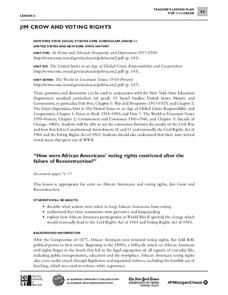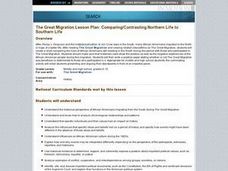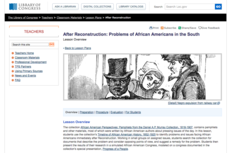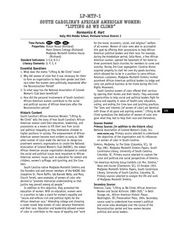City University of New York
Jim Crow and Voting Rights
Class groups examine primary source documents to determine how the voting rights of African Americans were restricted after the failure of Reconstruction, and how African American participation in World War II lead to change.
Curated OER
Comparing/Contrasting Northern Life to Southern Life
Learners compare and contrast the lives of African Americans who moved North vs. those who stayed in the South during the era of Jim Crow Laws.
Curated OER
African American Life during Jim Crow
Students examine Jim Crow laws using primary sources.
Curated OER
Segregation
Students consider the implications of prejudice. In this segregation lesson, students experience a simulation that has school staff favoring students with blue eyes. Students discuss the simulation experience, watch "The Eye of the...
Curated OER
No Day
Students learn about discrimination and the Jim Crow laws. In this discrimination instructional activity, students are presented with new classroom rules that discriminate against certain types of clothing. Students discuss the effects...
Pacific University Oregon
Civil Rights: US History
To gain an understanding of the Civil Rights Movement of the 1960s, class members investigate the Jim Crow Laws, the Emancipation Proclamation, the 13th, 14th, and 15th Amendments of the US Constitution, and the 1898 Supreme Court case,...
University of Arkansas
Promises Denied
"Promises Denied," the second instructional activity in a unit that asks learners to consider the responsibilities individuals have to uphold human rights, looks at documents that illustrate the difficulty the US has had trying to live...
Library of Congress
After Reconstruction: Problems of African Americans in the South
Lynchings, race riots, and Jim Crow laws were just a few examples of antagonism that African Americans faced after Emancipation. Class groups investigate these and other events, and prepare a presentation to inform the class about...
Curated OER
Segregated America
Students investigate Jim Crow laws. In this segregation instructional activity, students analyze images that display American segregation. Students use the provided questions to aid them in their evaluation of the images.
Facing History and Ourselves
The Legacies of Reconstruction
The final lesson in the seven-resource Reconstruction Era collection examines the legacies of Reconstruction. Class members investigate why the period has been called an "unfinished revolution," "a splendid failure," and "the second...
Curated OER
US Civil Rights Movement: Beginnings through the 60s
A real find for a U.S. History teacher, this presentation could supplement many class sessions about the Civil Rights Movement. Pictures of events, major figures, and "Whites Only" signs are striking and effective for even your most...
Curated OER
Todd Duncan: The First Porgy
Students view a video and conduct research about Jim Crow laws and their effects on race relations.
Curated OER
The Civil Rights Movement
Students examine the Jim Crow Laws and goals of the Civil Rights movement. They read and discuss handouts, answer questions, conduct research, and write an essay about the effects of the Civil Rights movement.
Curated OER
John Fox Slater and the Freedmen
Eleventh graders discover how Northern philanthropists fought against Jim Crow laws in the South. In this Reconstruction instructional activity, 11th graders analyze 2 letters written by John Fox Slater and determine what his motivations...
Curated OER
Negro Leagues Baseball and the Law
Students examine historical law and its impact on Negro Leagues Baseball and Black Americans. Students identify and research laws contributing to segregation or integration, and choose one law to reenact in a historically accurate manner.
Curated OER
Freedmen & Jim Crow
In this United States history worksheet, learners utilize a word bank of 10 terms or phrases to answer 10 fill in the blank questions about the African American experience following the Civil War. A short answer question is included as...
Curated OER
Seeking Civil Rights
Pupils explore the impact of the Plessy v. Ferguson case. In this social justice lesson, students examine the case, Jim Crow laws, and non-violent forms of protest. Pupils write essays to persuade the government regarding unjust laws.
Curated OER
Civil Rights
Young scholars study the social and political events in Virginia linked to desegregation and massive resistance and their relationship to national history. They examine the "Jim Crow" laws and how they affected the lives of African...
Curated OER
Making Democracy Work for Everyone, 1877-1904
Students investigate the culture of the post Reconstruction South. They participate in a jigsaw research activity, conduct Internet research on an assigned topic, and write a report to present to the class.
Curated OER
Latinos and the Fourteenth Amendment: A Primary Document Activity
Students explore Latinos and the Fourteenth Amendment. In this government and law lesson plan, students analyze the ruling in Hernandez v. Texas. Students predict how the United States would be different if the court had made an...
Curated OER
South Carolina's African American Women: "Lifting As We Climb"
Students explore the formation of the National Association of colored Women's Club. In this civil rights lesson, students research the history and mission of the NACWC.
Center for History and New Media
Growing Up in a Segregated Society, 1880s–1930s
What did segregation look like in the beginning of the 20th century? Middle and high schoolers view images of segregated areas, read passages by Booker T. Washington and W.E.B. DuBois, and come to conclusions about how the influence of...
Curated OER
Integration of Education
Students explore the history of Civil Rights and how the struggle for Civil Rights and the Second Reconstruction, transformed society and politics in the United States in the 1950s. Then they identify why American Schools are integrated...
Curated OER
Rosa Parks Changed the Rules
Students complete a diagram of the Montgomery bus that carried Rosa Parks into the history books. They read about Rosa Park's contributions to the Civil Rights movement. They role play Rosa Park's refusal to move to the back of the bus.

























